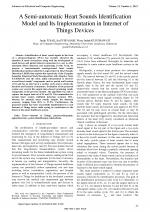| 1/2021 - 5 |
A Semi-automatic Heart Sounds Identification Model and Its Implementation in Internet of Things DevicesJUSAK, J. |
| Extra paper information in |
| Click to see author's profile in |
| Download PDF |
Author keywords
Internet of Things, phonocardiography, signal detection, system identification, telemedicine
References keywords
heart(16), signal(8), sounds(7), healthcare(6), access(6), time(5), system(5), sound(5), processing(5), security(4)
Blue keywords are present in both the references section and the paper title.
About this article
Date of Publication: 2021-02-28
Volume 21, Issue 1, Year 2021, On page(s): 45 - 56
ISSN: 1582-7445, e-ISSN: 1844-7600
Digital Object Identifier: 10.4316/AECE.2021.01005
Web of Science Accession Number: 000624018800005
SCOPUS ID: 85106421249
Abstract
Identification of heart sound signals in the form of a phonocardiogram (PCG) has recently attracted the attention of many researchers along with the development of small devices and global Internet connection in a way to offer automatic illness detection and monitoring. In this work, we propose a semi-automatic envelope-based heart sounds identification method called the Largest Interval Heart Sounds Detection (LiHSD) that exploits the superiority of the Complete Ensemble Empirical Mode Decomposition with Adaptive Noise (CEEMDAN) and the cubic spline interpolation to discover several heart sounds' components such as period and location of S1 and S2, an interval of a cardiac cycle, and to obtain the duration and location of murmurs. Evaluation of the proposed system over several life sample data showed promising results comparable to the previous models. The algorithm was able to capture the largest interval of S1 and S2. The examination for normal heart sounds exhibited detection accuracy 98 percent, whereas for anomaly heart sounds samples the detection accuracy ranging from 89 percent to 97.5 percent. Furthermore, the proposed system has been successfully implemented in a real Internet of Things device while eyeing its contribution to the future of the smart healthcare system. |
| References | | | Cited By |
Web of Science® Times Cited: 1 [View]
View record in Web of Science® [View]
View Related Records® [View]
Updated today
SCOPUS® Times Cited: 4
View record in SCOPUS® [Free preview]
View citations in SCOPUS® [Free preview]
[1] Denoising of Heart Sound Signal for Myocardial Infarction Detection Based on Adaptive Filtering, Puspasari, Ira, Mengko, Tati L.R., Setiawan, Agung W., Adiono, Trio, Pramudyo, Miftah, 2023 IEEE 5th Eurasia Conference on Biomedical Engineering, Healthcare and Sustainability (ECBIOS), ISBN 979-8-3503-2097-8, 2023.
Digital Object Identifier: 10.1109/ECBIOS57802.2023.10218715 [CrossRef]
[2] A New Tele-Healthcare System of Heart Sound Signal Classification based on Gated Recurrent Unit, Oktarina, Eka Sari, Akhmad Setiawan, Noor, Ardiyanto, Igi, 2021 International Conference on Artificial Intelligence and Big Data Analytics, ISBN 978-1-6654-0890-5, 2021.
Digital Object Identifier: 10.1109/ICAIBDA53487.2021.9689694 [CrossRef]
[3] A Heart Sound Diagnosis Processing Unit Based on LSTM Neural Network, Zhou, Weixin, Wang, Ang, Yu, Lina, Xiao, Wan'Ang, 2022 IEEE 4th International Conference on Circuits and Systems (ICCS), ISBN 978-1-6654-6036-1, 2022.
Digital Object Identifier: 10.1109/ICCS56666.2022.9936094 [CrossRef]
Disclaimer: All information displayed above was retrieved by using remote connections to respective databases. For the best user experience, we update all data by using background processes, and use caches in order to reduce the load on the servers we retrieve the information from. As we have no control on the availability of the database servers and sometimes the Internet connectivity may be affected, we do not guarantee the information is correct or complete. For the most accurate data, please always consult the database sites directly. Some external links require authentication or an institutional subscription.
Web of Science® is a registered trademark of Clarivate Analytics, Scopus® is a registered trademark of Elsevier B.V., other product names, company names, brand names, trademarks and logos are the property of their respective owners.
Faculty of Electrical Engineering and Computer Science
Stefan cel Mare University of Suceava, Romania
All rights reserved: Advances in Electrical and Computer Engineering is a registered trademark of the Stefan cel Mare University of Suceava. No part of this publication may be reproduced, stored in a retrieval system, photocopied, recorded or archived, without the written permission from the Editor. When authors submit their papers for publication, they agree that the copyright for their article be transferred to the Faculty of Electrical Engineering and Computer Science, Stefan cel Mare University of Suceava, Romania, if and only if the articles are accepted for publication. The copyright covers the exclusive rights to reproduce and distribute the article, including reprints and translations.
Permission for other use: The copyright owner's consent does not extend to copying for general distribution, for promotion, for creating new works, or for resale. Specific written permission must be obtained from the Editor for such copying. Direct linking to files hosted on this website is strictly prohibited.
Disclaimer: Whilst every effort is made by the publishers and editorial board to see that no inaccurate or misleading data, opinions or statements appear in this journal, they wish to make it clear that all information and opinions formulated in the articles, as well as linguistic accuracy, are the sole responsibility of the author.



